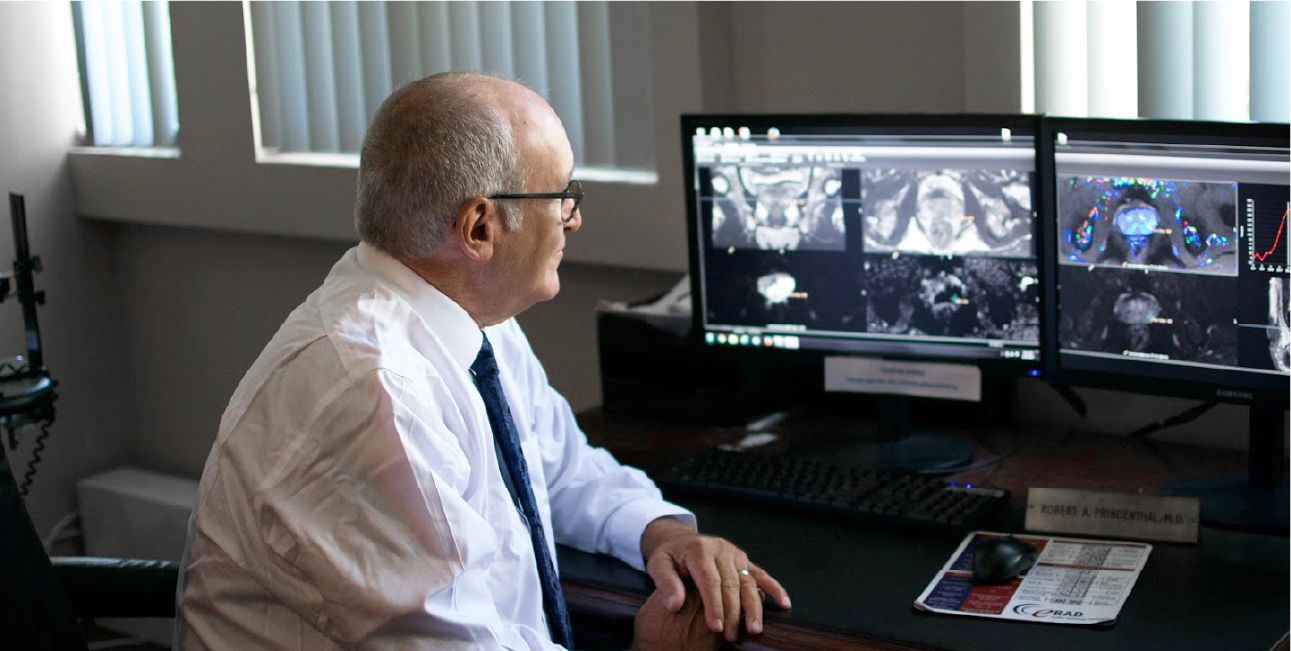
1-2 Canadian Medical Association Journal, 2019
Pathways to be a Candidate for Prostate MRI

DETECTION PATHWAY
The first pathway access is for patients who have an unexplained serum PSA, and have had at least one negative TRUS biopsy performed by a Urologist.
For these men, we offer a prostate cancer detection screen on a 3T magnet. T-2, DCE and DWI sequences are used to image the prostate. We do not feel the need to use an endorectal coil with our superior equipment to evaluate whether a patient’s prostate gland has a hidden cancer, or is normal.

STAGING PATHWAY
The second pathway is for men who have had a positive TRUS biopsy and know they have prostate cancer. Our STAGING protocol includes the same sequences as the detection protocol, with the addition of an endorectal coil for enhanced resolution and MRI spectroscopy. This allows us to precisely measure the tumor's size, extent, and activity. We can also determine if the cancer is confined within the gland or has spread beyond the capsule. Significant extracapsular extension often indicates that surgery may not be the best option, and radiation therapy might be a more suitable treatment.

RECURRENCE PATHWAY
The third pathway is for men who have been previously treated for prostate cancer with either surgery or radiation and have a PSA relapse.
Prostate MRI is useful to help identify where and how big a recurrent or metastatic focus of prostate cancer they may have.

"The main value of obtaining a prostate MRI is that it can help distinguish which men would benefit from a biopsy to evaluate a rising PSA, versus which men likely don't have cancer and can avoid a biopsy."
Robert Princenthal M.D.
Radiologist, Prostate Medical Director
Prostate MRI Background
MRI (magnetic resonance imaging) is a medical imaging technique that allows doctors to view detailed information on tissue and blood patterns found in the human body. Through the utilization of high-powered magnets a MRI machine can cause tissues in the body, include theprostate, to assume different appearances, thus revealing abnormal tissue.
Our dedicated Prostate MRI Program, using a multi-parametric approach to imaging, has shown increased sensitivity and specificity for cancer detection (around 85 – 90 percent).
- These improved results are based by critical analysis of four (4) specific imaging sequences.
- These include high anatomic quality T-2 weighted imaging and three functional sequences.
The functional sequences include:
- DWI (diffusion weighted imaging) analyzes the restriction of movement of water molecules seen with prostate cancer. DWI is quite accurate and correlates when positive to a specific Gleason Score upon a positive biopsy result.
- DCE (dynamic contrast enhancement), where a small amount of IV agent is injected to evaluate increased and abnormal bloodvessels seen with prostate cancer. These DCE images are obtained rapidly and analyzed with computer generated curves which look for increased flow and rapid washout.
- Images are obtained rapidly, 3 seconds per acquisition and reviewed to generate time function curves.
Benefits of Prostate MRI
Data from multiple early implementers of prostate MRI have explored the efficacy of prostate MRI and subsequent MRI-guided biopsy.
They found that the specificity and sensitivity for finding clinically significant prostate cancer (those with a Gleason score of 6 or higher and a volume exceeding 5 millimeters) was between 85 percent and 96 percent. Their data also show a negative predictive value around 95 percent, which means there was a 95 percent chance that no significant prostate tumor existed if prostate MRI did not identify a tumor.
If a tumor nodule was identified, it could be confirmed with a targeted, MRI-guided biopsy. The cancer detection rate for MRI directed biopsy is around 80 percent compared to 45 percent at time of first TRUS biopsy.
Prostate MRI provides several important
data points about a prostate cancer tumor(s).
IT CAN:
- Measure the extent of tumor volume.
- Identify the tumor’s location or locations in the gland.
- Estimate how aggressive the tumor is, which is critical to planning accurate biopsy guidance.
- Reveal staging information.
- Determine whether the tumor has spread beyond the prostate gland.
- Roughly 299,010 men will be diagnosed with prostate cancer this year - 35,250 men will die of prostate cancer.3
- There are more than 1 million prostate biopsies being performed each year.

3 American Cancer Society: 2024 Key Statistics for Prostate Cancer
For Physicians
The RadNet Prostate MRI Program offers referring physicians the ability to enhance and improve their local TRUS biopsy program. We hope the prostate MRI information on this website is helpful to the medical community. The protocols established by the MRI Program can help to assist with a higher yield of diagnostic accuracy, reduce infections, and promote fewer complications. The Prostate Program works in conjunction with your practice to provide referring physicians more detailed information to make treatment choices for their patients.
The Program will send key color images to referring physicians to help guide medical providers through the report. Follow-up conversations are available with the reading radiologists and/or a Program co-director upon request. The Program’s protocols include:
- Detection Protocol: for patients with a negative TRUS biopsy and unexplained elevated PSA. The scan will consist of protocols T2 imaging, DCE and DWI. No endo coil, no spectroscopy. Routine MRI safety screen plus an IV contrast prep.
- Prostate Cancer Staging Protocol: for patients who have had a recent biopsy proving cancer. In addition to the detection protocol the scan will be performed with an endo coil for optimal resolution and MR spectroscopy and IV contrast for the DCE sequences. This protocol should be used for active surveillance patients.
- Bones and Nodes Protocol: if a patient has a high pretest probability of metastatic prostate cancer we will perform a Bones and Nodes Protocol. This includes imaging the pelvis, lumbar spine and thoracic spine with T1 weighted images and diffusion/STIR images looking for bone metastasis and abnormal lymph nodes.
- Recurrence Protocol: for patients with rising PSA following either RT or surgery.
We Want To Hear From You
Prostate MRI
Call and we'll help schedule your Prostate MRI screening appointment and answer your questions.
Arizona: (480) 455-1850
Fresno: (559) 474-4290
Coachella Valley: (760) 318-2988
Victor Valley: (760) 951-2867
Inland Empire: (951) 682-1099
Antelope Valley: (661) 945-5855
Long Beach: (714) 784-1643
Los Angeles: (310) 854-7722
San Fernando Valley: (818) 616-6538
San Gabriel Valley: (626) 445-4850
Temecula Valley: (951) 587-8956
Ventura County: (805) 357-0067
Orange County: (714) 784-1643
Bakersfield: (661) 324-7000
TULSA Procedure
Call or submit the form to start the TULSA Procedure process with our team. We're here to guide you through each step and answer any questions you have.
TULSA Procedure Phone: (818) 480-7266
TULSA Procedure Fax: (818) 827-5152